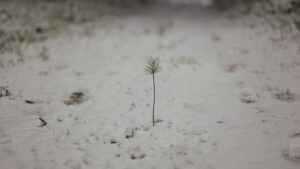
Filming in a lit forest in Moskosel at 3pm in the afternoon (sun sets at 2.30pm here in the north) on our third day of residency focused on the concept of courage. The first records of the word ‘courage’ come from the 1200s, from the Old French corage, from cuer, meaning “heart”. In re-listening to a recording of a conversation I hosted with dance artist Lauren Potter and civil engineer Ellie Cosgrave as part of A New Role for Dance in 2020, both of them spoke to something more related to a heart-space, rather than the muscle-bound concept of courage – they spoke about vulnerability. As part of their experiences as artists, specialists and teachers they spoke about how being a part of a creative process takes courage and how opening to learning with students rather than being the expert in the room at the front takes courage.
In reflecting on courage I entered this dark forest aware of the fear that women often feel in such spaces. There is almost an expected danger in entering dark spaces. Overcoming this – and knowing there is a safety in walking as a team of two, rather than one, I played with movement on and off the vertical axis, leaning and gently falling forward and backward, trusting the ground is there and that I was safe in my own vulnerability.
Christian positioned himself along the vertical axis – both near to the ground and standing while filming. Coming upon this fallen tree, bending into the light, my intuition was to crouch, sit still, and let the tree do the leaning. Christian sums this response to such spaces eloquently by saying, “Maybe the way dancers can hold a space to make it present and accessible to others is something nature tries to do for us, if we can only be given a little help in letting that happen”.
We remain curious as to how the qualities of dance and choreographic practice can engage with a space that is already moving, shifting and changing and to come into presence with it and, in collaboration, open up accessibility in new ways. How are the ways we move with landscapes courageous in the way we might open ourselves to it, listen and, like responsive teaching, open to what is already there and open it not only for others, but for ourselves as well. As Howard Gardner points out, […] personality and temperament are at least as important as cognitive powers. People who are judged creative take chances, take risks, are not afraid to fall down, and pick themselves up, they say “what can I learn from this?” and they go on.

Christian Kipp & Sara Wookey
www.christiankipp.com / www.sarawookey.com
References
https://www.etymonline.com/word/courage
Five Minds for the Future by Professor Howard Gardner (2008). This paper was given as an oral presentation at the Ecolint Meeting in Geneva, January 13, 2008.